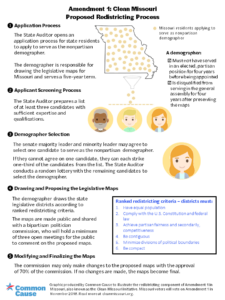The Missouri General Assembly is ignoring the will of the voters by placing Amendment 3 on the 2020 general election ballot.
In 2018, Missouri Amendment 1 introduced several political reforms to strengthen democracy in the state. The Clean Missouri initiative enhanced transparency guidelines, lowered campaign contribution limits, mandated stricter lobbying rules, and revamped the redistricting process for state legislative districts. The ballot initiative took the power to draw state legislative districts away from state legislators and give it to a non-partisan state demographer. It also established stronger criteria to create a more fair redistricting process.
Almost immediately, legislators began scheming to undo this landmark good government and voting rights reform. Legislators placed Amendment 3 on the November 2020 ballot to dismantle protections against gerrymandering and implement radical changes that target Missouri’s communities of color. Read Amendment 3 here. This measure would implement the following changes.
- Eliminate the position of nonpartisan demographer, who is selected in a bipartisan manner to draw state legislative districts, and returns the power to draw districts back to a redistricting commission that is handpicked by elected officials.
- Eliminate strict protections against drawing districts for partisan advantage and allows one party to enjoy a mathematical advantage that would match some of the worst state legislative gerrymanders in the last 40 years.
- Make Missouri the only state in the country to make approximately children and non-citizens invisible in our democracy by drawing districts based only on citizens of voting age. All states draw congressional districts based on total population and almost all of them also draw state legislative districts that way. No state excludes all children and non-citizens from being counted for redistricting purposes.
The scheme to draw districts based on total population was originally conceived by GOP gerrymandering mastermind Thomas Hofeller, who determined that it could be used to “advantage Republicans and non-Hispanic whites.”
Learn More About the Clean Missouri 2018 Initiative That Legislators Are Trying to Overturn
How Does Clean Missouri Rein in Gerrymandering?
Amendment 1 strips the Missouri State Legislature of the power to draw its own districts and gives that power to a non-partisan state demographer. The state demographer would be required to draw districts that are “designed in a manner that achieves both partisan fairness and, secondarily, competitiveness.” The measure defines partisan fairness as meaning that parties can “translate their popular support into legislative representation with approximately equal efficiency” and competitiveness as legislative representation that is “substantially and similarly responsive to shifts in the electorate’s preferences.”
Who Draws the Maps?
See our graphic on this reform proposal.
The state-appointed nonpartisan state demographer is responsible for drawing new state legislative maps. The existing bipartisan politician commission may make changes to the proposed plan with a seven-tenths vote of approval. If no changes are made, the plan is approved.
How Will the Non-Partisan State Demographer be Selected?
The state auditor will develop an application listing necessary qualifications to serve as the non-partisan state demographer. The state auditor will initiate an open application process and will review applications for qualified individuals.
The state auditor will provide a list of at least three applicants to the majority leader and minority leader of the senate. If the majority leader and minority leader of the senate can agree on an applicant, that applicant will be selected as the non-partisan state demographer.
If they are unable to agree on an applicant, each leader will be able to remove up to one-third of applicants. The state auditor will randomly choose from the remaining applicants to serve as the non-partisan state demographer.
Who Can Serve?
State residents who have not served in a partisan, elected position for four years before their appointment may apply with the state auditor to serve as the non-partisan state demographer.
How Can the Public Participate in the Drawing of New Districts?
After the non-partisan state demographer proposes a legislative redistricting plan, the commission will hold a minimum of three public hearings where the public will be able to comment on the proposed plan.
What Are the Proposed Rules for Drawing Maps?
- Redistricting must be based on total population
- Compliance with the United States Constitution and federal law
- Districts may not be drawn with the intent or result of negatively impacting racial minorities
- Districts will be drawn to achieve partisan fairness and secondarily, competitiveness
- Contiguity (making sure all parts of the district are connected)
- Respecting county, municipal, and township boundaries
- Compactness (keeping district lines close to its center)
